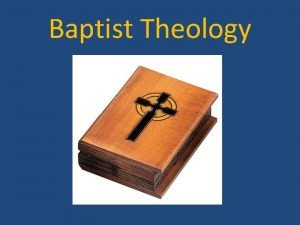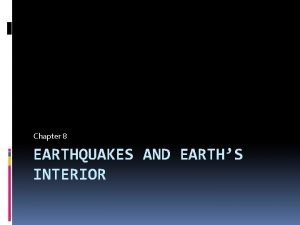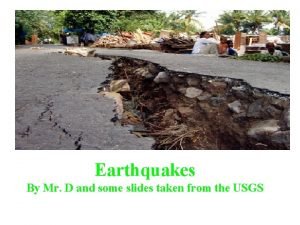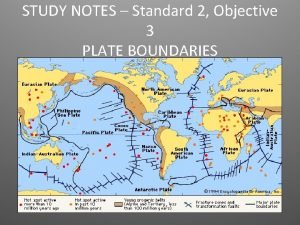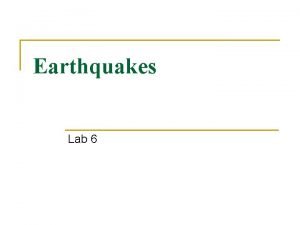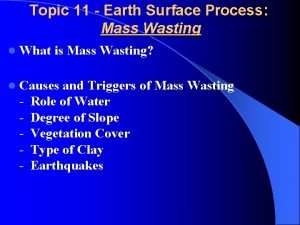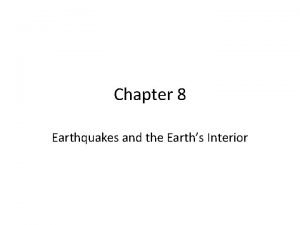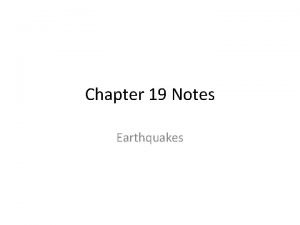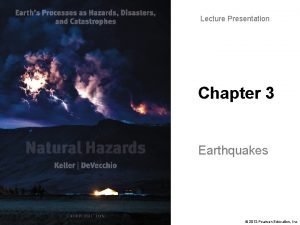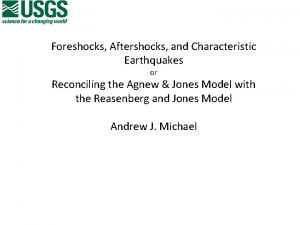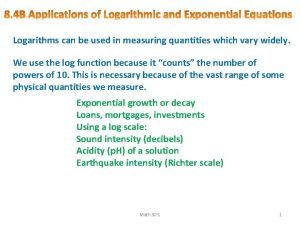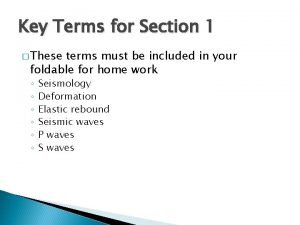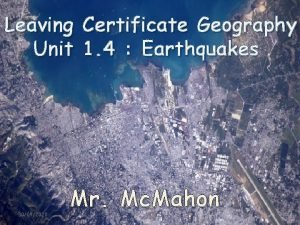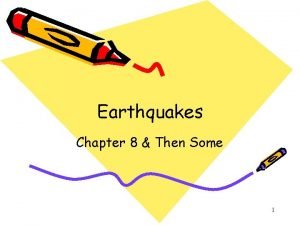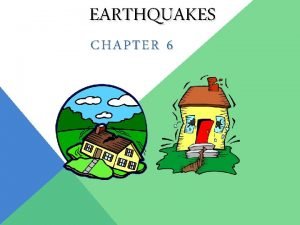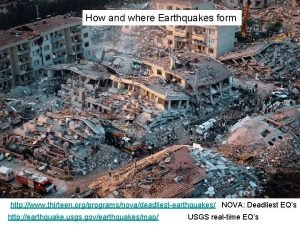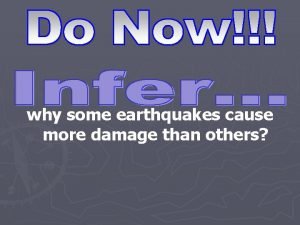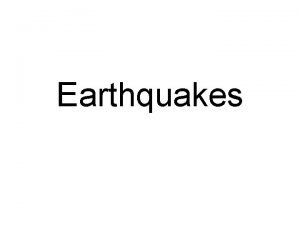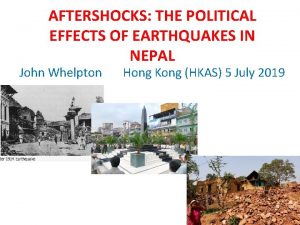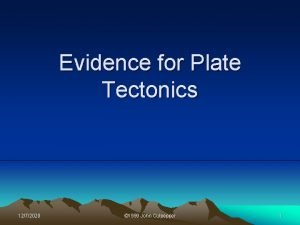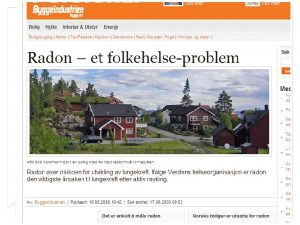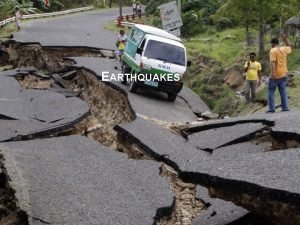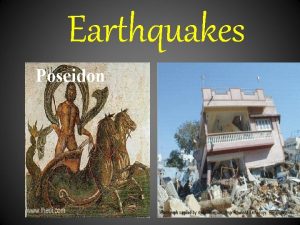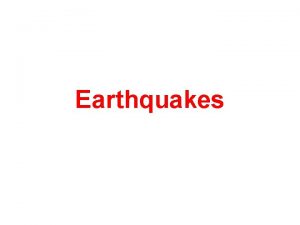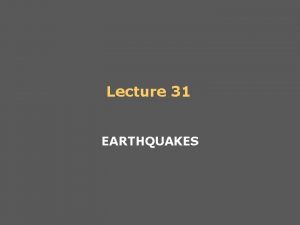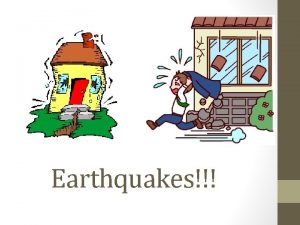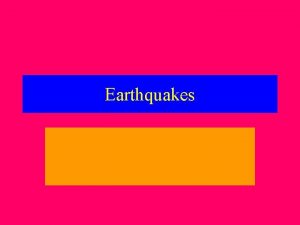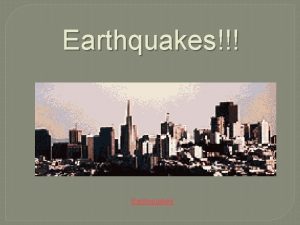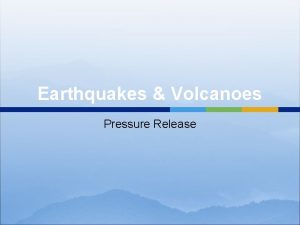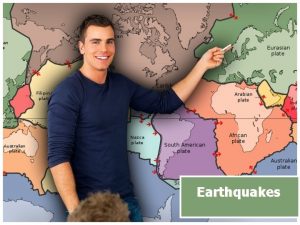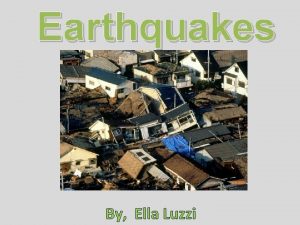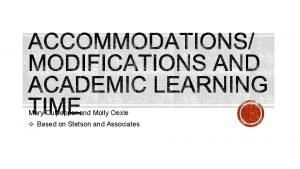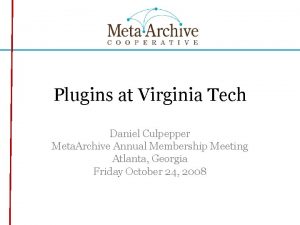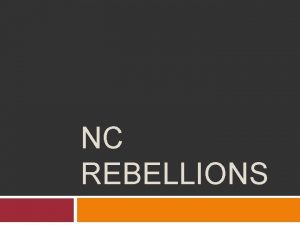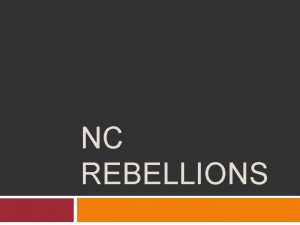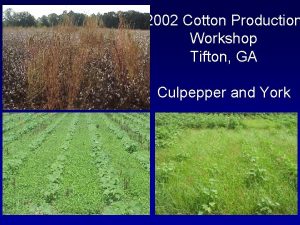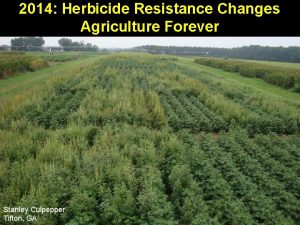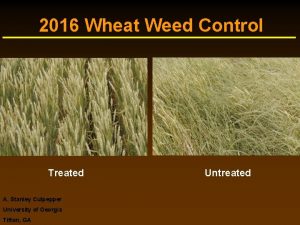Earthquakes 11222020 1999 John Culpepper 1 Earthquakes The




































- Slides: 36

Earthquakes 11/22/2020 © 1999 John Culpepper 1

Earthquakes • The movement of tectonic plates creates stress on large areas of rock • Stress within rocks can be relieved by – Bending – Stretching – Breaking 11/22/2020 © 1999 John Culpepper 2

Earthquakes • Occur when stress is relieved by rocks breaking 11/22/2020 © 1999 John Culpepper 3

Earthquakes (cont. ) • Usually occur along faults and plate boundaries • Energy is rapidly released in all directions (causing waves) – Like a pebble dropped in a quiet pool of water 11/22/2020 © 1999 John Culpepper 4

Types of Faults • Normal Fault – Hanging wall slides down the fault plane, – Formed by divergent boundary 11/22/2020 © 1999 John Culpepper 5

Reverse Fault (Thrust Fault) Hanging wall slides up the fault plane Formed by convergent boundary 11/22/2020 © 1999 John Culpepper 6

• Strike-slip Fault – Hanging wall and foot wall slide horizontally to the fault plane, – Formed by transform boundary 11/22/2020 © 1999 John Culpepper 7

Important Terms • Fault- a weakness or break in the Earth’s crust • Focus- the place underground where the break occurs (actual location of the earthquake) • Epicenter- the location on the Earth’s surface just above the focus (map location of an earthquake) 11/22/2020 © 1999 John Culpepper 8

Seismic waves • In an earthquake 3 kind of waves are produced – P-waves – Surface waves 11/22/2020 © 1999 John Culpepper 9

P-waves (primary waves) • Travel through solids and liquids • Fastest moving seismic waves 11/22/2020 © 1999 John Culpepper 10

S-waves (secondary waves) • Travel only through solid material • Move slower than Pwaves 11/22/2020 © 1999 John Culpepper 11

Surface waves • Do the most damage and move the slowest 11/22/2020 © 1999 John Culpepper 12

11/22/2020 © 1999 John Culpepper 13

Seismic waves are measured by seismometers • Seismic recordings are called seismograms or seismographs • Scientists who study earthquakes are called Seismologists 11/22/2020 © 1999 John Culpepper 14

11/22/2020 © 1999 John Culpepper 15

Earthquakes (cont. ) • The exact time of an earthquake is known as its origin time • Earth’s outer core is liquid – Only P-waves can travel through 11/22/2020 © 1999 John Culpepper 16

Earthquakes (cont. ) • Moho discontinuity -the boundary between Earth’s crust and mantle – Seismic waves speed up here 11/22/2020 © 1999 John Culpepper 17

Earth’s Interior • Within the Earth density, pressure, and temperature all increase with depth 11/22/2020 © 1999 John Culpepper 18

11/22/2020 © 1999 John Culpepper 19

Faults • Normal fault – Found in areas under tension • Where sections of the landscape are pulling apart Called Fault Block Mountains 11/22/2020 © 1999 John Culpepper 20

Faults (cont. ) • Reverse fault – Found in areas under compression • Zones of convergence Like the Himalaya Mountains 11/22/2020 © 1999 John Culpepper 21

Faults (cont. ) • Strike-slip faults – More horizontal movement than vertical movement Like the San Andreas fault in California 11/22/2020 © 1999 John Culpepper 22

Shadow zone • A zone on the opposite side of the earth from where an earthquake has occurred where seismic waves will not be felt – Due to the way that seismic waves travel through the different materials within the Earth 11/22/2020 © 1999 John Culpepper 23

11/22/2020 © 1999 John Culpepper 24

11/22/2020 © 1999 John Culpepper 25

Earthquake damage is measured by 2 scales: • Richter Scale 1 -10 each increase of 1=10 fold increase in shaking (exponential) • Mercalli Scale 1 -7 based on the damage to buildings and observed effects 11/22/2020 © 1999 John Culpepper 26

11/22/2020 © 1999 John Culpepper 27

11/22/2020 © 1999 John Culpepper 28

Deep, Intermediate, & Shallow Earthquakes • Deeper usually = stronger 11/22/2020 © 1999 John Culpepper 29

• Shallow EQ’s occur nearer the trench and deeper occur farther inland • This is due to subducting oceanic crust 11/22/2020 © 1999 John Culpepper 30

EQ 11/22/2020 © 1999 John Culpepper 31

Typical Seismogram 11/22/2020 © 1999 John Culpepper 32

How is an Earthquake’s Epicenter Located? 11/22/2020 © 1999 John Culpepper Seismic wave behavior – P waves arrive first, then S waves, then L and R – Average speeds for all these waves is known – After an earthquake, the difference in arrival times at a seismograph station can be used to calculate the distance from the seismograph to the epicenter. 33

How is an Earthquake’s Epicenter Located? Time-distance graph showing the average travel times for P- and Swaves. The farther away a seismograph is from the focus of an earthquake, the longer the interval between the arrivals of the P- and S- waves 11/22/2020 © 1999 John Culpepper 34

How is an Earthquake’s Epicenter Located? • • • Three seismograph stations are needed to locate the epicenter of an earthquake A circle where the radius equals the distance to the epicenter is drawn The intersection of the circles locates the epicenter 11/22/2020 © 1999 John Culpepper 35

Earthquake Practice: • How many seismic stations do you need to locate the epicenter of an earthquake? • An earthquake occurs 8000 km away, how long will it take P-waves to reach you? S-Waves? • P waves arrived at a seismic station at 12: 03, Swaves arrived at 12: 07. How far is the epicenter? 11/22/2020 © 1999 John Culpepper 36
 Baptist theology
Baptist theology Chapter 8 earthquakes and earth's interior answer key
Chapter 8 earthquakes and earth's interior answer key Types of earthquake
Types of earthquake A large crack in the earth formed by a river or earthquakes
A large crack in the earth formed by a river or earthquakes Do earthquakes happen
Do earthquakes happen Frequent earthquakes in an area may indicate *
Frequent earthquakes in an area may indicate * Crust definition
Crust definition Positive effects of earthquakes
Positive effects of earthquakes Mass wasting
Mass wasting Chapter 8 earthquakes and earth's interior
Chapter 8 earthquakes and earth's interior Chapter 19 earthquakes
Chapter 19 earthquakes In what section of earth do earthquakes happen?
In what section of earth do earthquakes happen? Pearson education
Pearson education Earthquakes
Earthquakes Causes of earthquake in points
Causes of earthquake in points Http://earthquake.usgs.gov/earthquakes/map/
Http://earthquake.usgs.gov/earthquakes/map/ Elastic rebound theory
Elastic rebound theory Chapter 19 earthquakes
Chapter 19 earthquakes Btn earthquakes
Btn earthquakes Causes of earthquake in points
Causes of earthquake in points Quiz 1 earthquakes
Quiz 1 earthquakes Whats the main cause of earthquakes
Whats the main cause of earthquakes Chapter 8 earthquakes and volcanoes
Chapter 8 earthquakes and volcanoes Why do earthquakes occur
Why do earthquakes occur The ______ of a seismograph moves.
The ______ of a seismograph moves. The point on the ground directly above the focus
The point on the ground directly above the focus Chapter 8 section 1 what are earthquakes answer key
Chapter 8 section 1 what are earthquakes answer key Earthquakes
Earthquakes Thế nào là hệ số cao nhất
Thế nào là hệ số cao nhất Hệ hô hấp
Hệ hô hấp Số nguyên tố là số gì
Số nguyên tố là số gì Tư thế ngồi viết
Tư thế ngồi viết đặc điểm cơ thể của người tối cổ
đặc điểm cơ thể của người tối cổ Mật thư tọa độ 5x5
Mật thư tọa độ 5x5 Glasgow thang điểm
Glasgow thang điểm ưu thế lai là gì
ưu thế lai là gì Thẻ vin
Thẻ vin
